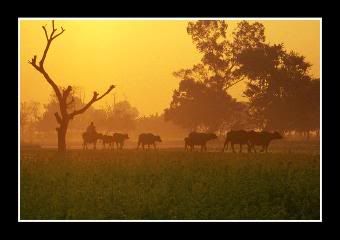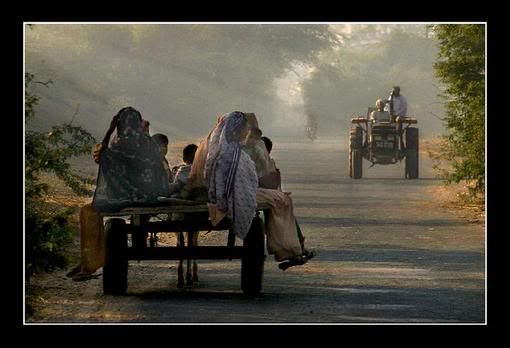Adil Najam
Every time I read one of Shirazi’s wonderful posts I am reminded of the fact that even though Pakistan is still a predominantly rural entity, the voices that speak about it are nearly entirely urban. Not surprisingly, we tend to speak about Pakistan in a mostly urban idiom, with a dominant urban bias, and using a strikingly urban imagery.
There is , of course, nothing wrong with the urban vernacular. It is, after all, the lived experience and felt reality of so many of us. However, there is something striking — and disturbing — about the near absence of the rural voice (Shirazi notwithstanding). This was not always so. An earlier generation of urban Pakistan was still very connected to the rural landscape; they were themselves rural migrants and understood the smells, the tastes, the sounds and the touch of rural Pakistan.
For too many urbanites in my generation and beyond, rural Pakistan is no longer a place you ‘go to’; it is a place you ‘pass through.’ In this age of motorways and airways, you pass through it as fast as possible; touching as little of it as you can. The tanga, the rail-garhi, the bus-larri (lorry) used to force us to stop and try out the wares of that platform, that bus-adda, that roadway khokha. There is no longer any need to stop and breathe in that little bit of rural freshness.
Politically, of course, we urbanites have turned the rural voice into the villian. The rural voice is the voice of the wadera, the jagirdar, the chaudhry, the sardar. To the extent that the vast majority of the rural proletariat enters the discourse, their role is merely that of observers on the periphery.
Conveniently, the ills we face are all of their making. We, the urban elite — at least in our own self-image — are the progressive, educated, enlightened forces being pulled down by the so-called ‘feudal’ tendencies of rural Pakistan. Even in less stark narratives, it is we the urban elites whose responsibility it is to bring — even if we have to drag them — rural Pakistan into the ikeesvien saddi (21st century). We are, and we must be, the benevolent modernizers of the ‘rural masses’ (‘masses’, of course, is that de-individualizing term of endearment that is always applied to them, but never to us).
All this, and more, I worry about. And when I do, one of the places I seek refuge in is the photographic portfolio of Umair Ghani, whose work we have featured on ATP before. Umair’s work speaks poignantly and beautifully of the reality of rural life in Pakistan (Punjab in the case of these pictures).
P.S. This is a repost of a post first published at ATP on August 10, 2006.























































The rural elite is there to exploit and rule, especially in sindh. Those who have read Siddique salik’s “emergency” or even the eventual exploitations in the “animal farm” know how similar the scene is in the interior of the country. It is very discomforting for the Pirs and Chaudries to see their haaris’ or mazaraas’ sons finish middle school let alone high school. Land reform is one way to fix the problem. Other basic steps, sound superfuous but can make a world of difference; schools with teachers, roads, telephone, electricity and with that internet and tv. Having spent the first 13 years of my life in tharparkar I know how badly these landlords need to be toppled. PPP had a chance but didn’t do it. Presently Musharraf has made a certain clan of the chaudris more powerful than ever before. MQM’s intent is noble on paper but they wreaked havoc when in power both officially and not officially (referring to the time when no political FIR could be filed in karachi and hyderabad without Altaf Hussain’s nod in the late 80s n early 90s). Feudalism and Religious Fundamentalism are two cancers that Pakistan has.
Good article and great blog. Bilal Zubairi had recommended it a while ago and this will now be one of my favorites going forward.
Excellent post – took me back to some of my very limited experiences in rural pakistan. While I completely agree that the urban elite must help the rural poor into the 21st century, I do think that a lot of that responsibility also lies with the “rural elite” and there are a lot of them. Someone born and raised and in Karachi, whose parents and grandparents migrated from India has little connection with the poor living in the Thar desert or Larkana. Even with the best of intentions their efforts are limited unless the rural powers (sardar, jagirdar etc.,) partner with them or support these eforts. I have always been amazed when I see people from such priviliged rural families who have been eudcated in the most liberal and progressive global institutions revert back to some of their backward and opporessive ways.
Not all is lost though. During some of my brief visits to Punjab I have some great examples of enlightened farmers (zagirdars) and progressive villages. Not sure why but some differences that stand out are smaller land holdings, greater agricultural income, and more infrastructure.
Your discussion on us wanting to bring the masses to the ikeesveen sadee made me think of ‘the white man’s burden’ and how we might be doing the same thing internally.
Adil and Bilal: “Ab woh choota sa alhar sa larka kahaan,” who should talk rural. It is a great thing that exceptions like you still smell and see in rural areas. Absolutely Pakistan post.
Adil: you raise an important issue. This forum is for Pakistanis to talk about Pakistan the way Pakistanis talk about Pakistan. But what do Pakistanis usually talk about? Every time I am in a discussion with Pakistani friends and colleagues I realize how their perspective of Pakistan is limited to the problems they faced growing up in urban centers. Either that, or brief recollections of the pinds they observed while on a train ride from Karachi to Lahore or Islamabad. What are the problems that rural (and most) Pakistanis face? Is it political uncertainty? is it national security? Is it digital oblivion? The pictures you have posted on rural Pakistan can be seen in at least 2 ways: (a) r a romantic view of village/rural life, and (b) a window into the hardships that rural Pakistan faces on a daily basis. While the first is attractive, the problem-solver in me wants to know the second better to identify how their problems can be better addresses in a sustainable way.